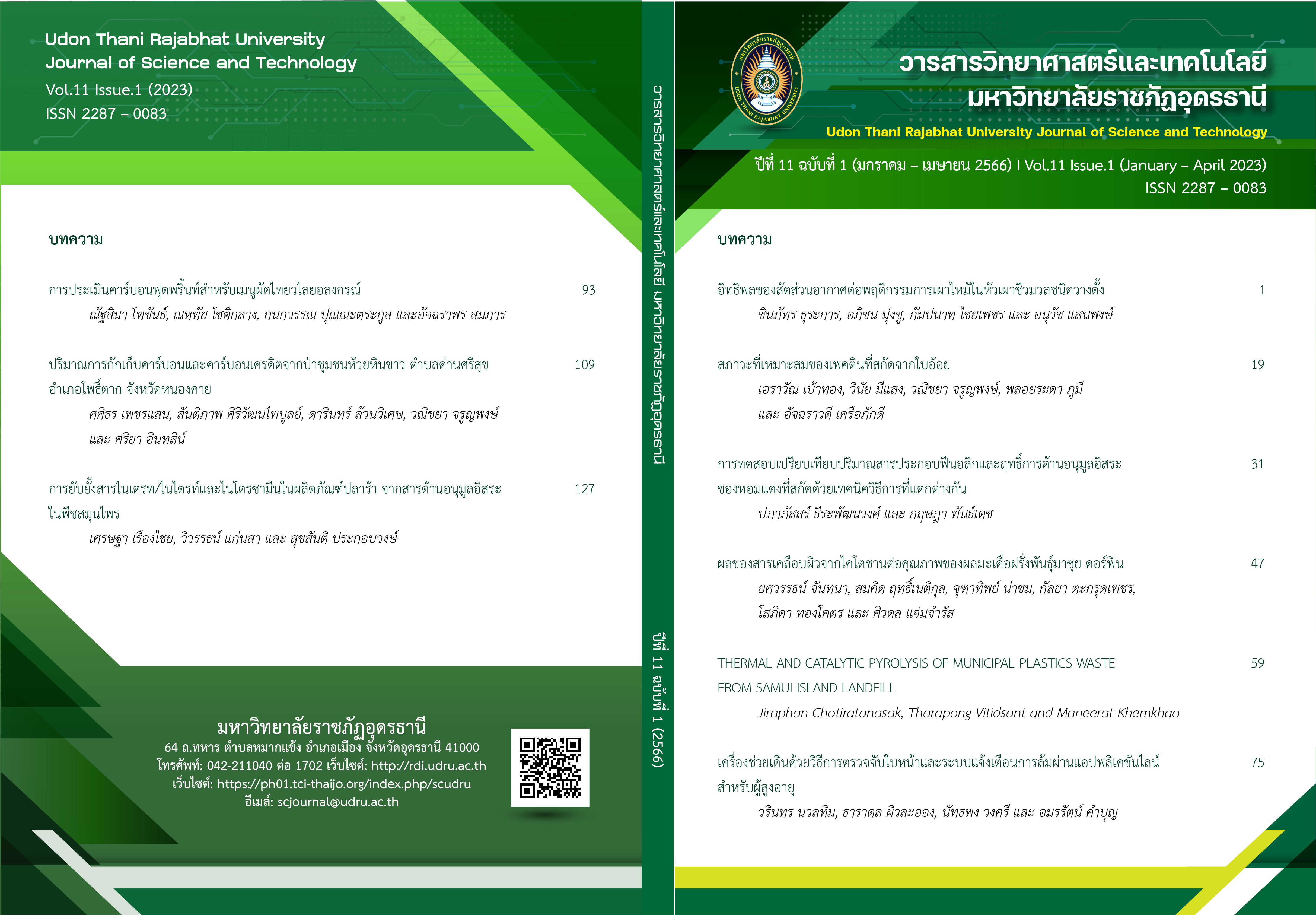OPTIMIZATION CONDITIONS OF PECTIN EXTRACTED FROM SUGARCANE LEAVES
Main Article Content
Abstract
The objective of this research was to find the optimization condition in pectin extracting procession from sugarcane leaves by hydrochloric acid solution. Designed treatment from the Minitab program and following main factor was pH, extraction time, and temperature. There were 15 treatments followed by 2-3 pH, extraction time was 30-240 min and the temperature was 60-90 oC. It was found that the best condition for yield was treatment 10; pH 3.0, extraction time 30 min, temperature 75 oC, and the yield was 22.65 percent. The lowest yield was treatment 1; pH 2.5, extraction time 135 min, 75 oC, and the yield was 8.65 percent. It was found that the main factor for extracting pectin from sugarcane leaves were pH and temperature.
Article Details
References
จุฑามาศ เลิศอยู่สุข, สุวรรณา ประณีตวตกุล และ ประเสริฐ ฉัตรวชิระวงษ์. (2561). การรับรู้และความพึงพอใจของเกษตรกรต่อคุณลักษณะวิธีการเก็บเกี่ยวอ้อยที่เป็นมิตรต่อสิ่ง แวดล้อมในจังหวัดเพชรบูรณ์. แก่นเกษตร, 46(2), 237-246.
เอราวัณ เบ้าทอง. (2561). แนวทางการใช้ประโยชน์เปลือกทุเรียนผสมเปลือกมะพร้าวในการสกัดเพกทิน. วารสารหน่วยวิจัยวิทยาศาสตร์ เทคโนโลยี และสิ่งแวดล้อมเพื่อการเรียนรู้, 9(2), 200-210.
Begum, R., Aziz, M. G., Uddin, M. B., & Yusof, Y. A. (2014). Chracterization of Jackfruit (Artocarpus heterophyllus) waste pectin as influenced by various extraction conditions. Agriculture and Agricultural Science Procedia, 2, 244-251.
Bichara, L. C., Alvarez, P. E., Bimb, M. V. F., Vaca, H., Gervasi, C., & Brandan, S. A. (2016). Structural and spectroscopic study of a pectin isolated from citrus peel by using FTIR and FT-Raman spectra and DFT calculations. Infrared Physics & Technology, 76, 315-327.
Blanco‑Pérez, F., Steigerwald, H., Schülke, S., Vieths, S., Toda, M., & Scheurer. S. (2021). The dietary fiber pectin: health benefits and potential for the treatment of allergies by modulation of gut microbiota. Current Allergy and Asthma Reports, 21(43), DOI: 10.1007/s11882-021-01020-z.
Dranca, F., & Oroian, M. (2018). Extraction, purification and characterization of pectin from alternative sources with potential technological applications. Food Research International, 113, 327-350.
Demirel, C., Kabutey, A., Herák, D., Sedlacek, A., Mizera, C., & Dajbych, O. (2022). Using box–behnken design coupled with response surface methodology for optimizing rapeseed oil expression parameters under heating and freezing conditions. Processes, 10, 490. https://doi.org/10.3390/pr1003 0490.
Fissore, A., Rojas, M., & Gerschenson, L. N. (2012). Rheological performance of pectin-enriched products isolated from red beet (Beta vulgaris L. var. conditiva) through alkaline and enzymatic treatments. Food Hydrocolloids, 26, 249 – 260.
Kurita, T., Fujiwara, E., & Yamazaki, E. (2008). Characterization of the Pectin Extracted from Citrus Peel in the Presence of Citric Acid. Carbohydrate Polymers, 74, 725-730.
Kyomugasho, C., Christiaens, S., Shpigelman, A., Loey, A. M. V., & Hendrickx, M. E. (2015). FT-IR spectroscopy, a reliable method for routine analysis of the degree of methylesterification of pectin in different fruit-and vegetable-based matrices. Food Chemistry, 176, 82-90.
López-Velázquez, L. Y., Salgado-García, S., Córdova-Sánchez, S., Valerio-Cárdena., C., Bolio-López, G. I., Castañeda-Ceja, R., LagunésEspinoza, L. del C., & Falconi Calderón, R. (2021). Characterization of cellulose and sugarcane (Saccharum spp.) straw from five cultivars grown in the humid tropic of Mexico. Agro Productividad, https://doi.org/10.32854/agrop.v14i9.2034.
Masmoudi, S., Besbes, M., Chaabouni, C., Robert, M., Paquot, C., Blecker, C., & Attia, H. (2008). Optimization of pectin extraction from lemon by-product with acidified date juice using response surface methodology. Carbohydrate Polymers, 74, 185–192.
Oliveira, T. I. S., Rosa, M. F., Canalcante, F. L., Pereira, P. H. F., Moates, G. K., Wellner, N., Mazzetto, S. E., Waldron, K. W., & Azerefo, H. M. C. (2016). Optimization of pectin extraction from banana peels with citric acid by using response surface methodology. Food Chemistry, 198, 113-118.
Roy, M. C., Alam, M., Saeid, A. Das, B. C., Mia, M. B., Rahman, M. A., Eun, J. B., & Ahmed, M. (2017). Extraction and characterization of pectin from pomelo peel and its impact on nutritional properties of carrot jam during storage. Journal of Food processing and Preservation., 42, 1-9.
Santos, J. D. G., Espeleta, A. F., Branco, A., & Assis, S. A. (2013). Aqueous Extraction of Pectin from Sisal Waste. Carbohydrate Polymer, 92, 1997-2001.
Sundarraj, A. A., Vasudevan, R. T., & Sriramulu, G. (2017). Optimized extraction and characterization of pectin from jackfruit (Artocarpus integer) wastes using response surface methodology. International Journal of Biological Macromolecules, 106(3), DOI: 10.1016/j.ijbiomac.2017.08.065.
Thirugnanasambandham, K., Sivakumar, V., & Maran, J. P. (2014). Process optimization and analysis of microwave assisted extraction of pectin from dragon fruit peel. Carbohydrate. Polymer, 112, 622-626.
Wai, W. W., Alkarkhi, A. F. M., & Easa, A. M. (2010). Effect of extraction conditions on yield and degree of esterification of durian rind Pectin: An experimental design. Food and Bioproduct Process, 88, 209-214.
Yang, J. S., Mu, T. H., & Ma. M. M. (2018). Extraction, structure, and emulsifying properties of pectin from potato pulp. Food Chemistry, 244, 197-205.


